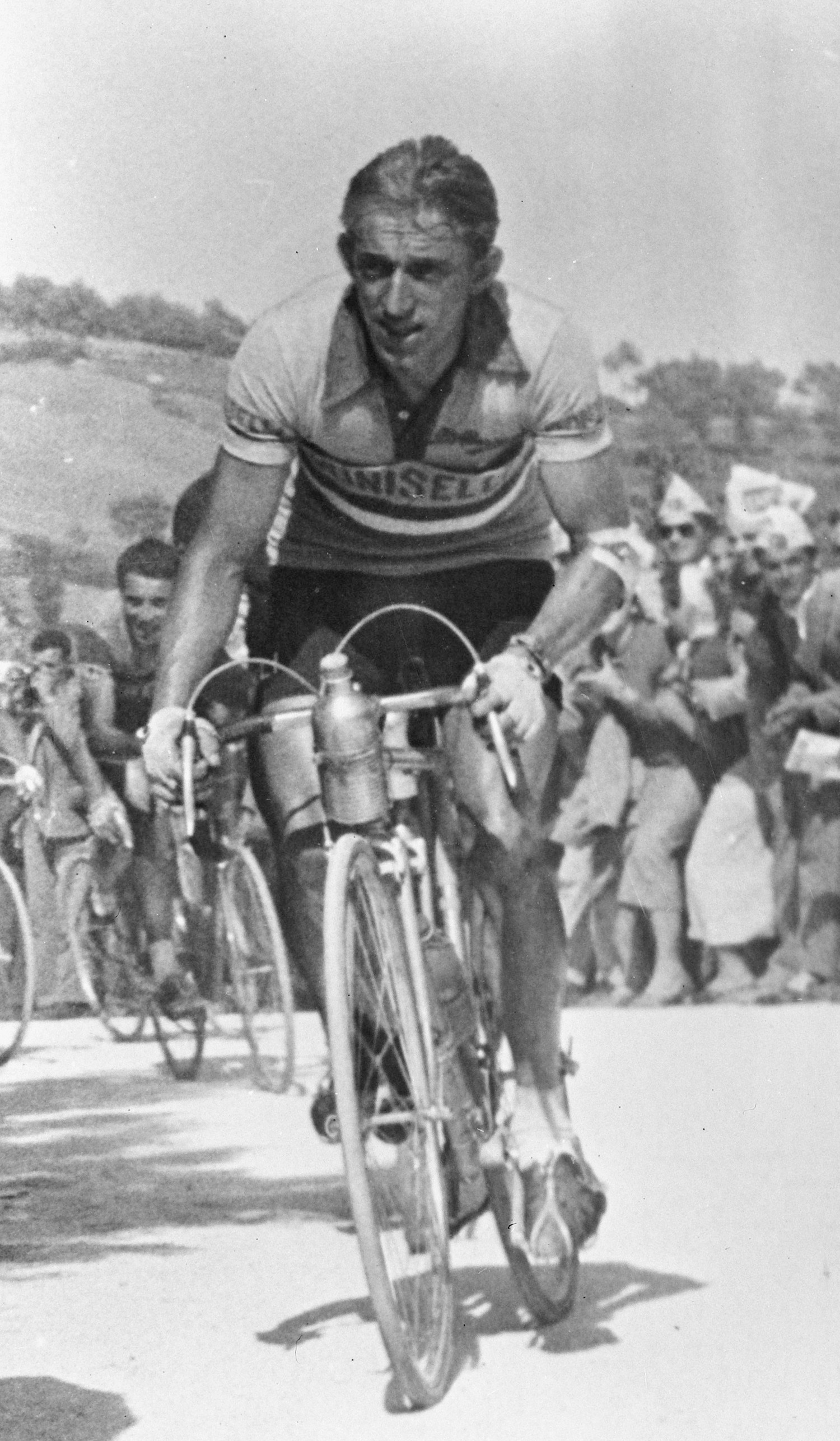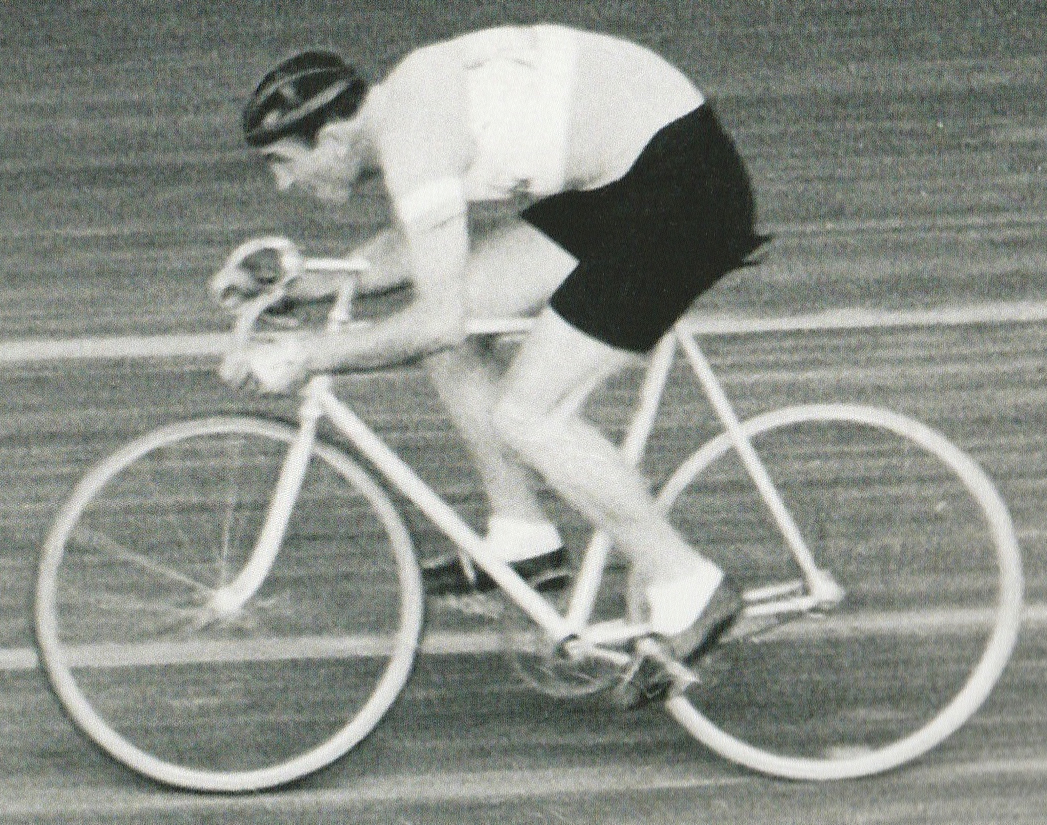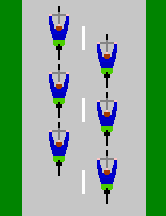|
1955 Giro D'Italia
The 1955 Giro d'Italia was the 38th edition of the Giro d'Italia, one of cycling's Grand Tours. The Giro started off in Milan on 14 May with a flat stage and concluded back in Milan with a relatively flat mass-start stage on 5 June. Fourteen teams entered the race, which was won by Italian Fiorenzo Magni of the Nivea-Fuchs team. Second and third respectively were Italian riders Fausto Coppi and Gastone Nencini. In the 20th stage, arriving in San Pellegrino Terme, Magni and Coppi attacked Gastone Nencini (who was leading the general classification) taking advantage of a puncture he suffered in an unpaved road section. Coppi won the stage (his last victory in the Giro) and Magni took the lead in the general classification. Teams Fourteen teams were invited by the race organizers to participate in the 1955 edition of the Giro d'Italia. Each team sent a squad of seven riders, which meant that the race started with a peloton of 98 cyclists. From the riders that began the race, ... [...More Info...] [...Related Items...] OR: [Wikipedia] [Google] [Baidu] |
Fiorenzo Magni
Fiorenzo Magni (; 7 December 1920 – 19 October 2012) was an Italian professional road racing cyclist. Biography Magni was born to Giuseppe Magni and Giulia Caciolli, and had an elder sister Fiorenza. Bulbarelli, pp. 14–15 He started competing in cycling in 1936, in secret from parents. His early successes became known to locals, including his parents, they allowed him to continue. After the death of his father in December 1937, Magni left school to take over his father's business and provide incomes for the family, yet he continued his cycling workouts. Shortly before the war in Italy on 10 June 1940, Magni was recruited to serve as a gunner at the 19th Regiment of Florence, although he had requested to become a bersagliere, while being licensed to dispute a race, its battalion was embarked for Albania, but the ship, where he should have been on board, also sank without leaving survivors. He moved to the Olympic Battalion of Rome where he remained until 1943 when h ... [...More Info...] [...Related Items...] OR: [Wikipedia] [Google] [Baidu] |
Guido Messina
Guido Messina (4 January 1931 – 10 January 2020) was an Italian road and track cyclist. He was born in Monreale, Italy, on 4 January 1931. On track he won five world titles in the individual 4000 m pursuit between 1948 and 1956, and a gold medal with the Italian team at the 1952 Olympics (individual pursuit became an Olympic event only in 1964, when Messina retired from cycling). Between 1954 and 1963 he rode professionally and won the first stage of the 1955 Giro d'Italia The 1955 Giro d'Italia was the 38th edition of the Giro d'Italia, one of cycling's Grand Tours. The Giro started off in Milan on 14 May with a flat stage and concluded back in Milan with a relatively flat mass-start stage on 5 June. Fourtee .... He died six days after his 89th birthday on 10 January 2020. References External links * * * 1931 births 2020 deaths People from Monreale Italian male cyclists Cyclists at the 1952 Summer Olympics Olympic cyclists of Italy Olympic gold med ... [...More Info...] [...Related Items...] OR: [Wikipedia] [Google] [Baidu] |
Perugia
Perugia (, , ; lat, Perusia) is the capital city of Umbria in central Italy, crossed by the River Tiber, and of the province of Perugia. The city is located about north of Rome and southeast of Florence. It covers a high hilltop and part of the valleys around the area. The region of Umbria is bordered by Tuscany, Lazio, and Marche. The history of Perugia goes back to the Etruscan period; Perugia was one of the main Etruscan cities. The city is also known as the University, universities town, with the University of Perugia founded in 1308 (about 34,000 students), the University for Foreigners Perugia, University for Foreigners (5,000 students), and some smaller colleges such as the Academy of Fine Arts "Pietro Vannucci" ( it, Accademia di Belle Arti "Pietro Vannucci") public athenaeum founded in 1573, the Perugia University Institute of Linguistic Mediation for translators and interpreters, the Music Conservatory of Perugia, founded in 1788, and other institutes. Perugia ... [...More Info...] [...Related Items...] OR: [Wikipedia] [Google] [Baidu] |
Giovanni Corrieri
Giovanni Corrieri (7 February 1920 – 22 January 2017) was an Italian professional road bicycle racer. Corrieri won 7 stages in the Giro d'Italia between 1947 and 1955. Corrieri died on 22 January 2017 at the age of 96 in Prato, Tuscany. Major results ;1945 :Giro della Provincia Di Reggio Calabria ;1947 : Giro d'Italia: ::Winner stage 12 ;1948 :: ::Winner stages 18 and 21 ;1949 : Giro d'Italia ...[...More Info...] [...Related Items...] OR: [Wikipedia] [Google] [Baidu] |
Viareggio
Viareggio () is a city and ''comune'' in northern Tuscany, Italy, on the coast of the Tyrrhenian Sea. With a population of over 62,000, it is the second largest city within the province of Lucca, after Lucca. It is known as a seaside resort as well as being the home of the famous carnival of Viareggio (dating back to 1873), and its papier-mâché floats, which (since 1925), parade along the promenade known as "Passeggiata a mare", in the weeks of Carnival. The symbol of the carnival of Viareggio and its official mask is Burlamacco, designed and invented by Uberto Bonetti in 1930. The city traces its roots back to the first half of the 16th century when it became the only gate to the sea for the Republic of Lucca. The oldest building in Viareggio, known as Torre Matilde, dates back to this time and was built by the Lucchesi in 1541 as a defensive fortification to fight the constant menace of corsair incursions. Viareggio is also an active industrial and manufacturing centre; ... [...More Info...] [...Related Items...] OR: [Wikipedia] [Google] [Baidu] |
Team Time Trial
A team time trial (TTT) is a road bicycle race in which teams of cyclists race against the clock (see individual time trial for a more detailed description of ITT events). The winning team in a TTT is determined by the comparing the times of (usually) the fourth-finishing rider in each team (though the relevant finish position can be otherwise specified in advance by the race organisers). This means that each team will try to get their first four (at least) riders across the finish line in a tight group: it is actually a disadvantage for any rider to finish far in advance of the fourth rider, as by staying back a faster rider can help the fourth rider to get a quicker time. Where a TTT is part of a stage race, it is necessary for each rider to be given a finish time that can be cumulated into the general classification timings. Hence, all riders in the team who finish in the leading bunch are given the time of the fourth rider, and any rider who has been dropped is timed indiv ... [...More Info...] [...Related Items...] OR: [Wikipedia] [Google] [Baidu] |
Time Trial
In many racing sports, an athlete (or occasionally a team of athletes) will compete in a time trial against the clock to secure the fastest time. The format of a time trial can vary, but usually follow a format where each athlete or team sets off at a predetermined interval to set the fastest time on a course. Variation in sports Cycling In cycling, for example, a time trial (TT) can be a single track cycling event, or an individual or team time trial on the road, and either or both of the latter may form components of multi-day stage races. In contrast to other types of races, athletes race alone since they are sent out in intervals (interval starts), as opposed to a mass start. Time trialist will often seek to maintain marginal aerodynamic gains as the races are often won or lost by a couple of seconds. Skiing In cross-country skiing and biathlon competitions, skiers are sent out in 30 to 60 second intervals. Rowing In rowing, time trial races, where the boats are se ... [...More Info...] [...Related Items...] OR: [Wikipedia] [Google] [Baidu] |
Albaro
Albaro is an affluent residential neighbourhood of the Italian city of Genoa, located east of the city centre. It was formerly an independent comune, named San Francesco d'Albaro, included in the city of Genoa in 1873. At present, together with the neighbourhoods of and is part of the Genoa's city VIII Municipio (Medio Levante). From the 16th to the 19th century Albaro was a renowned holiday resort for the Genoese upper class, who lived in the city and during summer used to move to their villas in Albaro. Nowadays it is a wealthy residential neighborhood, where during the last century next to the historic villas apartment buildings have been built, most of them with broad exclusive green spaces. For few months, from September 1822 to July 1823, the romantic poet Lord Byron lived here. The English writer Charles Dickens spent in Albaro the summer of 1844, and here he wrote the short novel ''The Chimes''. A well known hamlet of Albaro is Boccadasse, a fishermen's village at the ... [...More Info...] [...Related Items...] OR: [Wikipedia] [Google] [Baidu] |
Giancarlo Astrua
Giancarlo Astrua (11 August 1927 – 29 July 2010) (Italian). Gazzetta.it. 30 July 2010 was an Italian professional . He was born in . Major results ;1949 : Giro d'Italia: ::5th place overall classification ;1950 : Giro d'Italia: ::Winner ...[...More Info...] [...Related Items...] OR: [Wikipedia] [Google] [Baidu] |
Genoa
Genoa ( ; it, Genova ; lij, Zêna ). is the capital of the Italian region of Liguria and the List of cities in Italy, sixth-largest city in Italy. In 2015, 594,733 people lived within the city's administrative limits. As of the 2011 Italian census, the Province of Genoa, which in 2015 became the Metropolitan City of Genoa, had 855,834 resident persons. Over 1.5 million people live in the wider metropolitan area stretching along the Italian Riviera. On the Gulf of Genoa in the Ligurian Sea, Genoa has historically been one of the most important ports on the Mediterranean Sea, Mediterranean: it is currently the busiest in Italy and in the Mediterranean Sea and twelfth-busiest in the European Union. Genoa was the capital of Republic of Genoa, one of the most powerful maritime republics for over seven centuries, from the 11th century to 1797. Particularly from the 12th century to the 15th century, the city played a leading role in the commercial trade in Europe, becoming one o ... [...More Info...] [...Related Items...] OR: [Wikipedia] [Google] [Baidu] |
Alessandro Fantini
Alessandro Fantini (Fossacesia, 1 January 1932 — Trier, West-Germany, 5 May 1961) was an Italian professional road bicycle racer. Fantini died after a crash at the end of the sixth stage of the 1961 Tour of Germany. Major results ;1955 :Tour de France: ::Winner stage 12 ;1956 :Tour de France: ::Winner stage 7 : Giro d'Italia: ::6th place overall classification ;1957 : Giro d'Italia: ::Winner stage 5 ;1960 :Milano–Vignola The Milano–Vignola was a professional road bicycle race held annually in the Province of Modena, Italy Italy ( it, Italia ), officially the Italian Republic, ) or the Republic of Italy, is a country in Southern Europe. It is located in t ... External links *Official Tour de France results for Alessandro Fantini 1932 births 1961 deaths People from Fossacesia Italian male cyclists Italian Tour de France stage winners Cyclists who died while racing Sport deaths in Germany Cyclists from Abruzzo Sportspeople from the Province of Chieti< ... [...More Info...] [...Related Items...] OR: [Wikipedia] [Google] [Baidu] |
Acqui Terme
Acqui Terme (; pms, Àich ) is a city and ''comune'' in the province of Alessandria, Piedmont, northern Italy. It is about south-southwest of Alessandria. It is one of the principal winemaking communes of the Italian DOCG wine Brachetto d'Acqui. The city's hot sulphur springs have been famous since this was the Roman town of ''Aquae Statiellae''; the ancient baths are referred to by Paulus Diaconus and the chronicler Liutprand of Cremona. In 1870 Giovanni Ceruti designed a small pavilion, known as ''La Bollente'', for the spot at the centre of the town where the waters bubble up at . History During the Roman period, the region was connected by road with Alba Pompeia and Augusta Taurinorum (Turin) and was populated by the local Celto- Ligurian tribe of the Statielli. The region was subject to Roman rule after their main center, Carystum (Acqui Terme), was attacked in 173 BC by the legions led by the consul Marcus Popilius Laenas. The Statielli did not oppose the resistance, ... [...More Info...] [...Related Items...] OR: [Wikipedia] [Google] [Baidu] |



